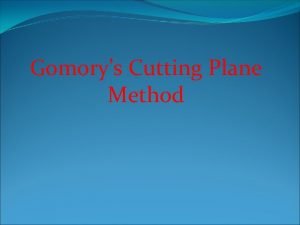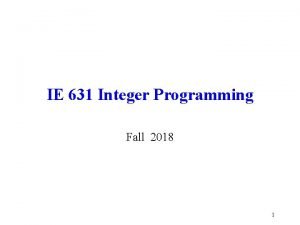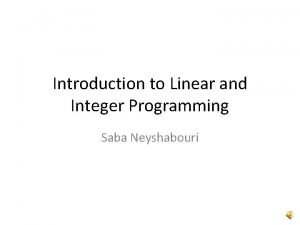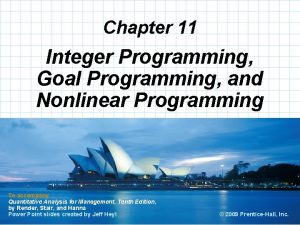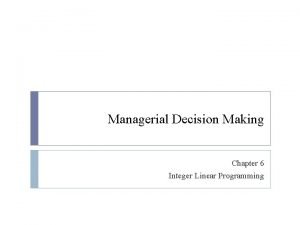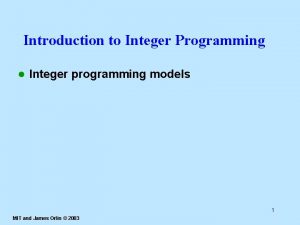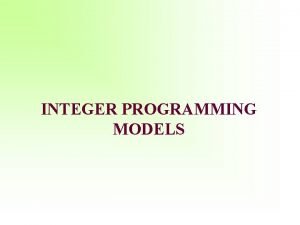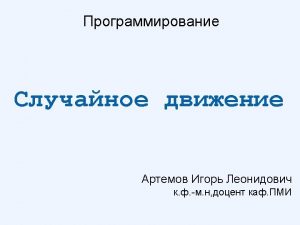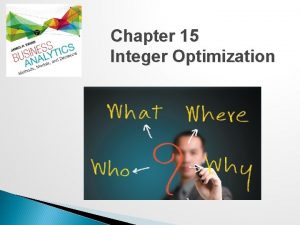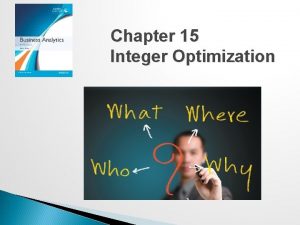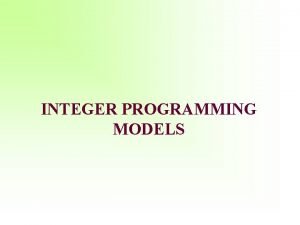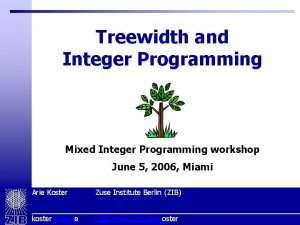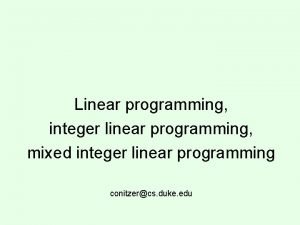Integer Programming Integer programming is a solution method













- Slides: 13

Integer Programming • Integer programming is a solution method for many discrete optimization problems • Programming = Planning in this context • Origins go back to military logistics in WWII (1940 s). • In a survey of Fortune 500 firms, 85% of those responding said that they had used linear or integer programming. • Why is it so popular? – Many different real-life situations can be modeled as integer programs (IPs). – There are efficient algorithms to solve IPs.

Standard form of integer program (IP) maximize c 1 x 1+c 2 x 2+…+cnxn (objective function) subject to a 11 x 1+a 12 x 2+…+a 1 nxn b 1 (functional constraints) a 21 x 1+a 22 x 2+…+a 2 nxn b 2 …. am 1 x 1+am 2 x 2+…+amnxn bm x 1, x 2 , …, xn Z+ (set constraints) Note: Can also have equality or ≥ constraint in non-standard form.

Example of Integer Program (Production Planning-Furniture Manufacturer) • Technological data: Production of 1 table requires 5 ft pine, 2 ft oak, 3 hrs labor 1 chair requires 1 ft pine, 3 ft oak, 2 hrs labor 1 desk requires 9 ft pine, 4 ft oak, 5 hrs labor • Capacities for 1 week: 1500 ft pine, 1000 ft oak, 20 employees (each works 40 hrs). • Market data: profit demand table $12/unit 40 chair $5/unit 130 desk $15/unit 30 • Goal: Find a production schedule for 1 week that will maximize the profit.

Production Planning-Furniture Manufacturer: modeling the problem as integer program The goal can be achieved by making appropriate decisions. First define decision variables: Let xt be the number of tables to be produced; xc be the number of chairs to be produced; xd be the number of desks to be produced.

Production Planning-Furniture Manufacturer: modeling the problem as integer program Ø Objective is to maximize profit: max 12 xt + 5 xc + 15 xd Ø Functional Constraints capacity constraints: pine: 5 xt + 1 xc + 9 xd 1500 oak: 2 xt + 3 xc + 4 xd 1000 labor: 3 xt + 2 xc + 5 xd 800 market demand constraints: tables: xt ≥ 40 chairs: xc ≥ 130 desks: xd ≥ 30 Ø Set Constraints xt , x c , x d Z+

Solutions to integer programs • A solution is an assignment of values to variables. • A feasible solution is an assignment of values to variables such that all the constraints are satisfied. • The objective function value of a solution is obtained by evaluating the objective function at the given point. • An optimal solution (assuming maximization) is one whose objective function value is greater than or equal to that of all other feasible solutions. • There are efficient algorithms for finding the optimal solutions of an integer program.

Next: IP modeling techniques Modeling techniques: ØUsing binary variables ØRestrictions on number of options ØContingent decisions ØVariables with k possible values Applications: ØFacility Location Problem ØKnapsack Problem

Example of IP: Facility Location • A company is thinking about building new facilities in LA and SF. • Relevant data: capital needed expected profit 1. factory in LA $6 M $9 M 2. factory in SF $3 M $5 M 3. warehouse in LA $5 M $6 M 4. warehouse in SF $2 M $4 M Total capital available for investment: $10 M • Question: Which facilities should be built to maximize the total profit?

Example of IP: Facility Location • Define decision variables (i = 1, 2, 3, 4): • Then the total expected benefit: 9 x 1+5 x 2+6 x 3+4 x 4 the total capital needed: 6 x 1+3 x 2+5 x 3+2 x 4 Ø Summarizing, the IP model is: max 9 x 1+5 x 2+6 x 3+4 x 4 s. t. 6 x 1+3 x 2+5 x 3+2 x 4 10 x 1, x 2, x 3, x 4 binary ( i. e. , xi {0, 1} )

The Facility Location Problem: adding new requirements • Extra requirement: build at most one of the two warehouses. The corresponding constraint is: x 3 +x 4 1 • Extra requirement: build at least one of the two factories. The corresponding constraint is: x 1 +x 2 ≥ 1

Modeling Technique: Restrictions on the number of options • Suppose in a certain problem, n different options are considered. For i=1, …, n • Restrictions: At least p and at most q of the options can be chosen. • The corresponding constraints are:

Modeling Technique: Contingent Decisions Back to the facility location problem. • Requirement: Can’t build a warehouse unless there is a factory in the city. The corresponding constraints are: x 3 x 1 (LA) x 4 x 2 (SF) • Requirement: Can’t select option 3 unless at least one of options 1 and 2 is selected. The constraint: x 3 x 1 + x 2 • Requirement: Can’t select option 4 unless at least two of options 1, 2 and 3 are selected. The constraint: 2 x 4 x 1 + x 2 + x 3

More on Integer Programming and other discrete optimization problems and techniques: • Math 4620 Linear and Nonlinear Programming • Math 4630 Discrete Modeling and Optimization
 Integer number
Integer number Perbedaan linear programming dan integer programming
Perbedaan linear programming dan integer programming Integer programming vs linear programming
Integer programming vs linear programming Definisi integer
Definisi integer Gomory cutting plane method steps
Gomory cutting plane method steps Linear vs integer programming
Linear vs integer programming Integer programming course
Integer programming course Linear integer programming
Linear integer programming Integer programming problem
Integer programming problem Fixed charge problem integer programming
Fixed charge problem integer programming Integer programming mit
Integer programming mit Integer programming example
Integer programming example Vrp
Vrp Mixed integer linear programming
Mixed integer linear programming




